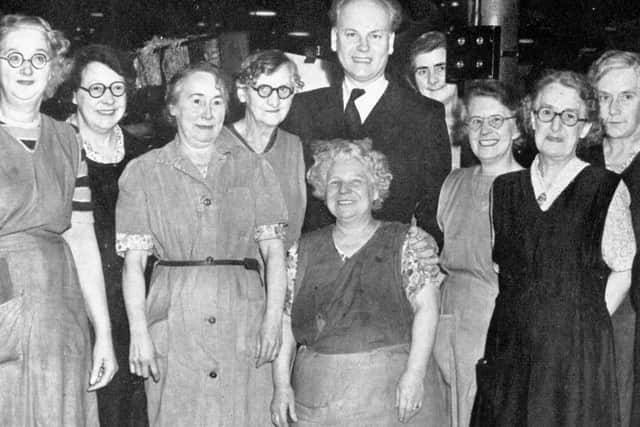The Nostalgia column with Margaret Watson: Broadcaster’s visit put working mill women in the spotlight


No wonder he caused a local sensation when he decided to visit a Dewsbury mill shortly after the Queen’s coronation in 1952.
He was here looking for material for his book entitled “The Queen’s Countrywomen” which was all about working women.
Advertisement
Hide AdAdvertisement
Hide AdThe author came to Wormalds and Walker’s mill in Thornhill Lees to talk to women weavers about their work.


He chose this particular mill because it was the largest blanket manufacturing mill in the country and employed over 1,000 women.
Staff at the mill were thrilled when they read the book to find he had devoted a whole chapter to the mill and spoken in glowing terms about the workers.
The chapter was entitled “The Power behind the Looms” and no mill could have had a better advert than his glowing comments on their famous blankets.
Advertisement
Hide AdAdvertisement
Hide AdHe marvelled at their striped red and black blankets worn by the warriors of Basutoland who draped them about their shoulders at warrior feasts.
The author was also impressed by blankets made exclusively for the trappers of the Hudson Bay Company in the frozen reaches of northern Canada.
He also wrote about the Chinese wedding blankets, which no Chinese bride would be without, and the famous Dormy blankets every British bride put on her wedding present list.
Godfrey Winn was surprised to witness one of the mill’s oldest traditions – the discharging of the ten o’clock gun.
Advertisement
Hide AdAdvertisement
Hide AdHe described in detail how the night-watchman took an ancient blunderbuss from the wall and pointed it to the sky before pressing the trigger.
It was sounded at that time every night to assure the townspeople that all was well – a custom dating back to the days of the Luddite rioters.
The author stayed at the home of the chairman of the company, P.J. Walker, and shared a supper of roast venison before a blazing fire with Mr Walker and Billy Walker, the managing director.
He described them as delightful companions who clearly had a great deal more to them than their charm of manner.
Advertisement
Hide AdAdvertisement
Hide AdHe wrote of their ‘crusading belief in the strength and national importance of all long-established family businesses, where any man could go and speak to the boss without first putting in for half-a dozen interviews with trade union intermediaries’.
The author wrote in praise of the women weavers whom he described as working with patience and resignation, lip-reading each other’s chatter above the unceasing uproar of the looms, asking few questions of their bosses.
He wrote: “Male operatives were much more stubborn than the female of their species, and once a man rose to be foreman, he was a ‘little god’ in his own weaving shed.”
But there was one young lady at the mill to whom he paid special attention and whom he described as the prettiest young lady in the place.
Advertisement
Hide AdAdvertisement
Hide AdShe was Shirley Young, a 20-year-old wages’ clerk who, in the year of the Festival of Britain, had been crowned Miss Dormy 1951.
It was during that year P.J. Walker took the whole works, 1,400 of them, with their families, to London, visiting the Festival by day and the Battersea Fun Fair at night.
The author also wrote about Dorine Thompson with the “brilliant Titian hair” who he saw carrying a basketful of fresh spindles across the yard.
Also, Mrs Shepherd, who had worked at the mill all her life, getting up at the break of dawn and who said she had no intention of retiring.
Advertisement
Hide AdAdvertisement
Hide AdHe was also impressed by Harry Bradshaw, who worked in the pulling department, and was an international rugby league player at the weekend.
The author couldn’t believe that the previous Saturday Harry had been playing against Wales, and on the Monday morning was back working at the mill.
He wrote: “Harry Bradshaw is back at work, but as his hands go about their usual tasks, all his thoughts are concentrating on the possibilities of being awarded his cap for England and being chosen for the team that was booked to tour Australia in a few months’ time.”
Godfrey Winn must have surely had his eyes opened while visiting the mill, especially when he spoke about the uplifting story of another mill worker – George Morris.
Advertisement
Hide AdAdvertisement
Hide AdHe included in his chapter how Mr Morris had brought up five children, all of whom had passed for grammar school, four of whom had become head teachers.
One of them, Willie Morris had gained eight distinctions in his Matric at Wheelwright Grammar School and won a scholarship to Oxford.
He had then competed with the best brains of his age, gaining one of the very few, coveted vacancies in the Foreign Service, and later becoming Ambassador to Egypt.
The author concluded his chapter with high praise for the warmth of Dewsbury people.
Advertisement
Hide AdAdvertisement
Hide AdHe described them thus – “A very fair people, fair in their dealings with each other, from t’boss downwards, fair in their greeting to strangers – though rightly giving one a canny glance or two of cautious appraisal – and fair enough to look at.”
Sadly, this once famous mill is no longer with us, having closed in 1983, but we still have our memories of those happy days.